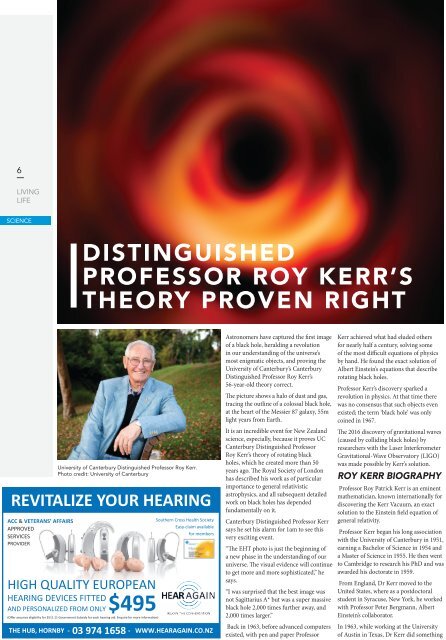Living Life: April 25, 2019
Create successful ePaper yourself
Turn your PDF publications into a flip-book with our unique Google optimized e-Paper software.
6<br />
LIVING<br />
LIFE<br />
SCIENCE<br />
DISTINGUISHED<br />
PROFESSOR ROY KERR’S<br />
THEORY PROVEN RIGHT<br />
University of Canterbury Distinguished Professor Roy Kerr.<br />
Photo credit: University of Canterbury<br />
REVITALIZE YOUR HEARING<br />
ACC & VETERANS’ AFFAIRS<br />
APPROVED<br />
SERVICES<br />
PROVIDER<br />
HIGH QUALITY EUROPEAN<br />
HEARING DEVICES FITTED<br />
AND PERSONALIZED FROM ONLY $495<br />
(Offer assumes eligibility for $511.11 Government Subsidy for each hearing aid. Enquire for more information)<br />
THE HUB, HORNBY <br />
03 974 1658<br />
Southern Cross Health Society<br />
Easyclaim available<br />
for members<br />
WWW.HEARAGAIN.CO.NZ<br />
Astronomers have captured the first image<br />
of a black hole, heralding a revolution<br />
in our understanding of the universe’s<br />
most enigmatic objects, and proving the<br />
University of Canterbury’s Canterbury<br />
Distinguished Professor Roy Kerr’s<br />
56-year-old theory correct.<br />
The picture shows a halo of dust and gas,<br />
tracing the outline of a colossal black hole,<br />
at the heart of the Messier 87 galaxy, 55m<br />
light years from Earth.<br />
It is an incredible event for New Zealand<br />
science, especially, because it proves UC<br />
Canterbury Distinguished Professor<br />
Roy Kerr’s theory of rotating black<br />
holes, which he created more than 50<br />
years ago. The Royal Society of London<br />
has described his work as of particular<br />
importance to general relativistic<br />
astrophysics, and all subsequent detailed<br />
work on black holes has depended<br />
fundamentally on it.<br />
Canterbury Distinguished Professor Kerr<br />
says he set his alarm for 1am to see this<br />
very exciting event.<br />
“The EHT photo is just the beginning of<br />
a new phase in the understanding of our<br />
universe. The visual evidence will continue<br />
to get more and more sophisticated,” he<br />
says.<br />
“I was surprised that the best image was<br />
not Sagittarius A* but was a super massive<br />
black hole 2,000 times further away, and<br />
2,000 times larger.”<br />
Back in 1963, before advanced computers<br />
existed, with pen and paper Professor<br />
Kerr achieved what had eluded others<br />
for nearly half a century, solving some<br />
of the most difficult equations of physics<br />
by hand. He found the exact solution of<br />
Albert Einstein’s equations that describe<br />
rotating black holes.<br />
Professor Kerr’s discovery sparked a<br />
revolution in physics. At that time there<br />
was no consensus that such objects even<br />
existed; the term ‘black hole’ was only<br />
coined in 1967.<br />
The 2016 discovery of gravitational waves<br />
(caused by colliding black holes) by<br />
researchers with the Laser Interferometer<br />
Gravitational-Wave Observatory (LIGO)<br />
was made possible by Kerr’s solution.<br />
ROY KERR BIOGRAPHY<br />
Professor Roy Patrick Kerr is an eminent<br />
mathematician, known internationally for<br />
discovering the Kerr Vacuum, an exact<br />
solution to the Einstein field equation of<br />
general relativity.<br />
Professor Kerr began his long association<br />
with the University of Canterbury in 1951,<br />
earning a Bachelor of Science in 1954 and<br />
a Master of Science in 1955. He then went<br />
to Cambridge to research his PhD and was<br />
awarded his doctorate in 1959.<br />
From England, Dr Kerr moved to the<br />
United States, where as a postdoctoral<br />
student in Syracuse, New York, he worked<br />
with Professor Peter Bergmann, Albert<br />
Einstein’s collaborator.<br />
In 1963, while working at the University<br />
of Austin in Texas, Dr Kerr did something


















